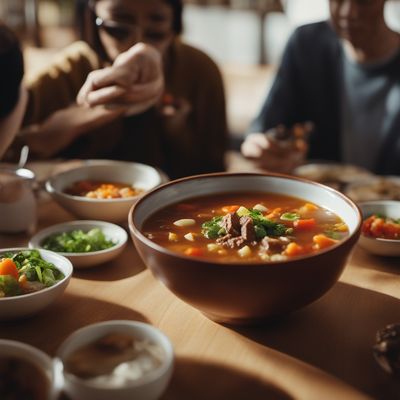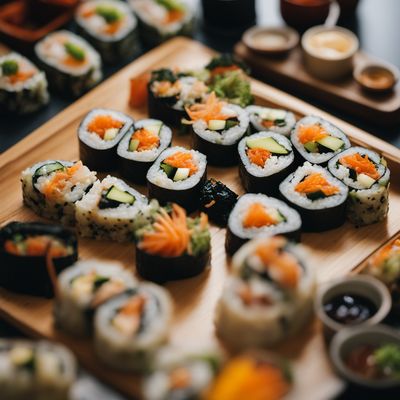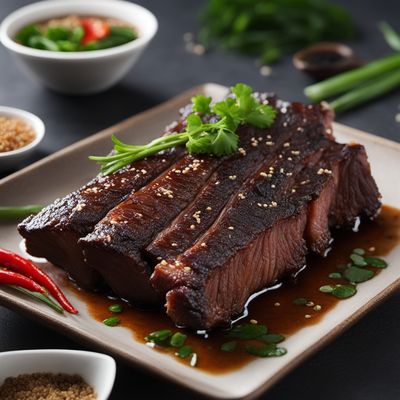
Recipe
Refreshing Buckwheat Noodles with Spicy Sauce
Chilled Delight: Spicy Makguksu Noodles
4.5 out of 5
Makguksu is a traditional Korean dish that features chewy buckwheat noodles served in a flavorful spicy sauce. This dish is perfect for hot summer days as it is served chilled, providing a refreshing and satisfying meal.
Metadata
Preparation time
20 minutes
Cooking time
10 minutes
Total time
30 minutes
Yields
4 servings
Preparation difficulty
Easy
Suitable for
Vegetarian, Vegan, Dairy-free, Nut-free, Gluten-free (if using gluten-free buckwheat noodles)
Allergens
Soy (in soy sauce), Sesame (in sesame oil)
Not suitable for
Paleo, Keto, Low-carb, High-protein, High-fat
Ingredients
-
250g (8.8 oz) buckwheat noodles 250g (8.8 oz) buckwheat noodles
-
2 tablespoons gochujang (Korean red chili paste) 2 tablespoons gochujang (Korean red chili paste)
-
2 tablespoons soy sauce 2 tablespoons soy sauce
-
1 tablespoon rice vinegar 1 tablespoon rice vinegar
-
2 cloves garlic, minced 2 cloves garlic, minced
-
1 tablespoon sesame oil 1 tablespoon sesame oil
-
1 cucumber, thinly sliced 1 cucumber, thinly sliced
-
4 radishes, thinly sliced 4 radishes, thinly sliced
-
1 cup kimchi 1 cup kimchi
-
1 tablespoon sesame seeds 1 tablespoon sesame seeds
-
2 green onions, chopped 2 green onions, chopped
Nutrition
- Calories (kcal / KJ): 320 kcal / 1340 KJ
- Fat (total, saturated): 6g, 1g
- Carbohydrates (total, sugars): 60g, 5g
- Protein: 10g
- Fiber: 6g
- Salt: 2g
Preparation
-
1.Cook the buckwheat noodles according to the package instructions. Drain and rinse with cold water to cool them down.
-
2.In a bowl, mix together gochujang, soy sauce, rice vinegar, minced garlic, and sesame oil to make the spicy sauce.
-
3.In a large mixing bowl, combine the chilled noodles with the spicy sauce. Toss well to coat the noodles evenly.
-
4.Divide the noodles into serving bowls. Top with cucumber slices, radish slices, kimchi, sesame seeds, and green onions.
-
5.Serve the makguksu chilled and enjoy!
Treat your ingredients with care...
- Buckwheat noodles — Be careful not to overcook the noodles as they can become mushy. Rinse them with cold water after cooking to stop the cooking process and cool them down quickly.
- Gochujang — Adjust the amount of gochujang according to your spice preference. Add more for a spicier sauce or reduce it for a milder flavor.
- Kimchi — Use store-bought kimchi or make your own for an authentic taste. If you prefer a milder flavor, rinse the kimchi before adding it to the dish.
Tips & Tricks
- For a refreshing twist, add a squeeze of fresh lime juice to the spicy sauce.
- Customize the toppings to your liking by adding shredded carrots, bean sprouts, or thinly sliced beef.
- If you prefer a vegetarian version, omit the kimchi or use a vegan-friendly kimchi.
- Make a larger batch of the spicy sauce and store it in the refrigerator for future use in other Korean dishes.
- To make the dish more filling, serve it with a side of steamed rice or a bowl of Korean-style vegetable pancakes.
Serving advice
Serve the makguksu in individual bowls, garnished with additional sesame seeds and green onions. Provide chopsticks and spoons for easy eating. It is best enjoyed chilled, making it a perfect dish for hot summer days.
Presentation advice
To enhance the presentation, arrange the toppings in an aesthetically pleasing manner on top of the noodles. The vibrant colors of the cucumber, radish, and kimchi will create an eye-catching dish. Sprinkle some extra sesame seeds and green onions on top for added visual appeal.
More recipes...
For Makguksu
For Korean cuisine » Browse all
More Korean cuisine dishes » Browse all

Soyo
Beef and vegetable soup
Soyo is a Korean soup made with soybean paste and vegetables.

Samgak gimbap
Triangle kimbap
Samgak gimbap is a type of Korean sushi that is shaped like a triangle. It is a popular snack that is easy to eat on the go.

Pyeonsu
Pyeonsu is a traditional Korean dish that is typically served as an appetizer. The dish consists of a thin dough that is filled with a mixture of...





